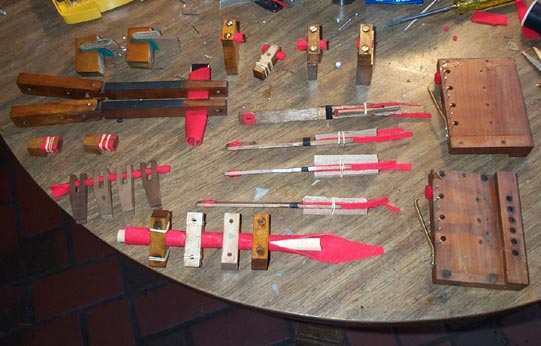
Chapter 11 - The Trapwork on the Keybed
After the keybed is installed, various trapwork
must be refurbished and installed on it, before the keyboard or anything
above it is put in. This apparatus has several functions:
1. While most of the stop action is pneumatic, two of the stops,
the 'muted strings' and the 'Aeolian harp', require physical manipulation
of mutes on the reed ranks. Two rollers on each side carry this motion
from the end of the stop board in the middle, to vertical links at the
extreme edges of the instrument.
2. The right knee lever operates the swell shutters in front
of the ranks. A roller and levers carries this motion from the knee
swell lever to a vertical link to the shutters.
3. The left knee lever, the crescendo or "Tonal", actuates a
pair of cams which successively open the stop action tubes, as the knee
lever is pushed farther toward the left, gradually increasing the number
of ranks turned on, regardless of the stop knob settings.
4. For the two 'mechanical' stops, the Tonal knee lever turns
their rollers toward "on" at the appropriate point in the crescendo buildup.
Both these Tonal functions are done by a huge roller which extends the
full width of the keybed, and is linked to the knee lever.
All the rods and rollers are cleaned up with Naval Jelly and steel wool, and the many bushed parts and pillow blocks are rebushed. The thin sticks that transfer motion from the Tonal roller to the four mechanical stop rollers have a bushed slot in the ends. Naturally the thin wood was split on two of them, and the other two were threatening. So the splits were mended, and the sticks reinforced by whipping them with heavy thread and glue, just like the wooden sticks in a tracker organ. Johan Liljencrants will appreciate an instance where his other favorite traditional technology, seafaring, shares a common method with organ work. An interesting production trick used by Aeolian, that I have never seen before; some of the pillow blocks have to be opened to install the rod. They were not made in two halves, but in one piece, with the bushed hole through the middle. After the bushing dried, the block was split in two with a froe or a chisel to make the two halves; clever! The split blocks are shown held together with gumbands for rebushing.

Through the organ, Aeolian used a special patent bushed 'bearing ' for all the small diameter rollers. It consists of two "question mark" shaped pieces of D-shaped cotter pin wire, and a piece of felt or cloth held in the "O" formed by two "?" facing each other. The tails of the two facing "D" shaped wires form a round pin, which is driven into a tightly fitting hole in the wood. The insides of the lops are stuck to the cloth with thick shellac, and held together with gumbands to dry. Later I discovered that adhesive is not needed. Once one gets the hang of it, the two loops and the cloth square can be just pinched together with the fingers, and the pin started in its hole. Then the whole thing is driven home with a hammer.
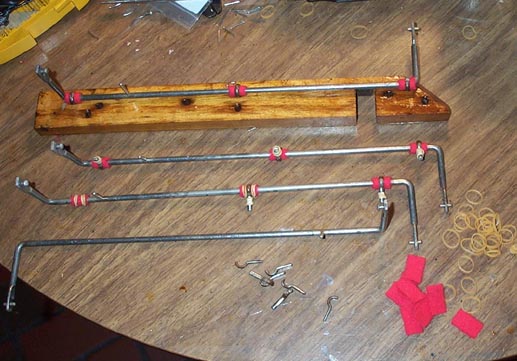
The two Tonal cam assemblies are held above the keybed on plywood legs. Three of these had split or delaminated, so I had to make ones. Here is a rig to make the angled cuts on the table saw.
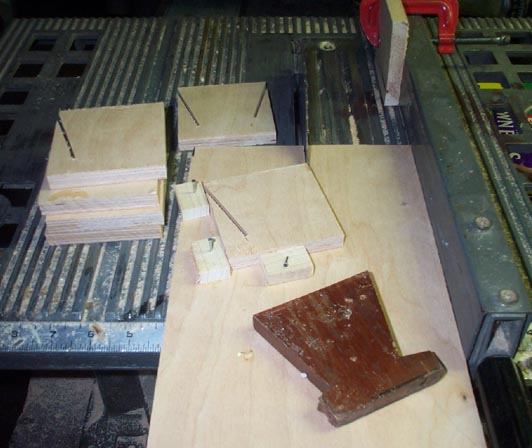
New spring for the cams were made out of #13-1/2 piano wire, to replace the originals which were bent up, rusted or crudely replaced in the past. I think that it is important to experiment with the bending rig to get the spring shapes correct, then use them as bent, without any further bending by hand. All the springs should have approximately the same force when installed. Otherwise the cam bar will not naturally center itself between the arrays of pallets, and the pallets will not open in the proper order as the cam bar is closed. The stop tube pallets are releathered, and the cam bar and the pallets are graphited with the wet finger.
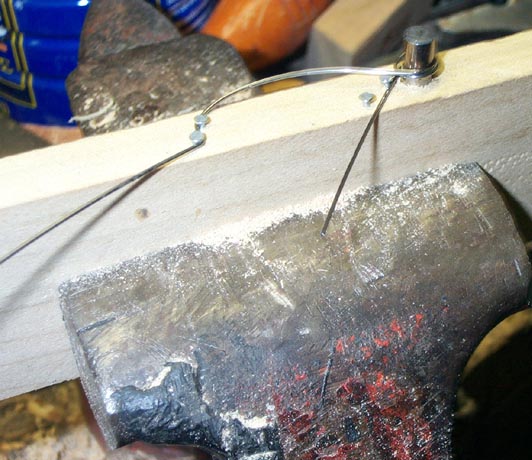
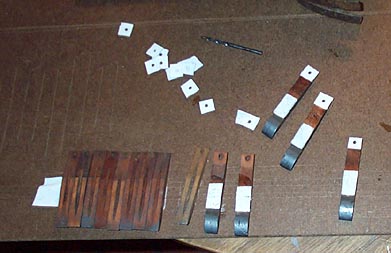
Here are two views of the Tonal devices assembled. There are two nipple holes on the block for each pallet, one on top and one on the back edge. These serves as a 'tee' in each stop tube, to connect the stop knob valves, the stop primaries, and the Tonal pallet without a brass tee. A "Big Ben" alarm clock sacrificed its main spring for the leaf springs under the cam bars, which had long ago been lost.
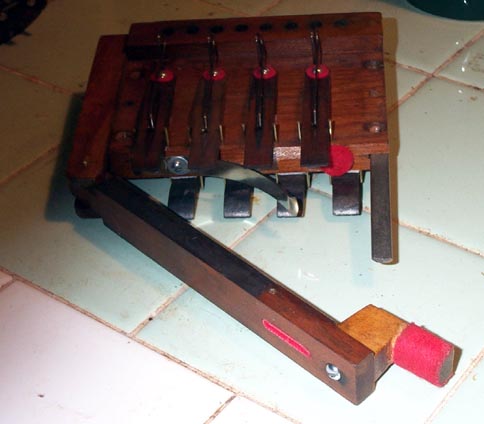
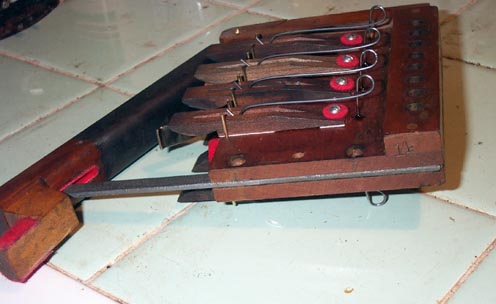
Two views of everything assembled on the keybed. Each pillow block for the long Tonal roller had to be carefully shimmed with business cards, so that the four bushed holed ended up in line regardless of any deflection in the keybed, and the roller turned freely. The "L" shaped rods in the front are pushed outwards by the knee levers hinged to the case. The second picture shows the Tonal action clearly.
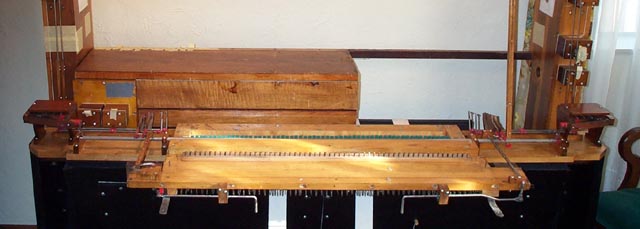
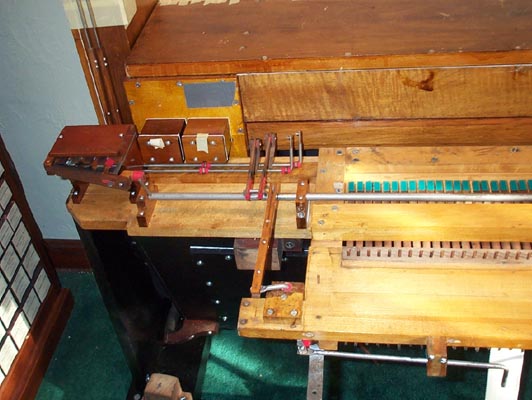
An interesting feature is the way they made the ends of the link rods or trackers. The details are too small to photograph clearly, so I made a drawing instead.
The principal is, that to unhitch these links, the long slot is pried apart with a screwdriver. The thin wood is supposed to be springy enough to do this. The wire part of the longer links was bent and rusted, so I made new wires from 1/8" rod, threaded 6-32 at one end. Two of the link bars were short, and made without a wire middle; just clip slots at both ends. Some of these flimsy things had split, and two of them had the lever holes split off. They were mended, and cut short and redrilled for the levers where needed. Later, I went back and whipped the ends of the sticks where the wires were clamped or threaded in, to add rigidity and prevent any future splitting. I am curious why Aeolian used this elaborate and flimsy arrangement here, rather than the famous Aeolian patent clip buckle, which every rebuilder has seen on all their pianos and pipe organs.